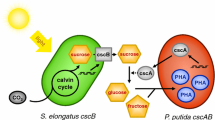Abstract
Microbial poly(3-hydroxybutyrate) (PHB) has been used as bioplastic, while the biopolymer of glucose (glycogen) can be used as efficient substrate for the generation of biofuels. Substantial production of PHB and glycogen by heterotrophic microbes has been constrained by the limited resources of organic substrates. Hence, the heterotrophic cultivation that efficiently converts an organic substrate to the two biopolymers is desirable. However, limited research has been conducted to examine the conversion efficiency of an organic substrate to biopolymers by photoheterotrophic microbes. In this study, the single-stage cultivation of a photoheterotrophic cyanobacterium (Chroococcus hansgirgi TISTR 8561) which accumulates PHB and glycogen was optimized and evaluated for the mass conversion efficiency (CE) of an organic substrate to the two biopolymers. The cells were cultured in BG11 trace element medium with addition of only a single specific organic substrate under light to enable both cellular oxygenic photosynthesis and heterotrophic metabolism, which were evidenced by the oxygen gas evolution and the organic substrate utilization of the cells, respectively. Through optimization of the culture conditions, organic substrate supply, and cultivation time, the mass CE of glucose to both PHB and glycogen of 51 ± 15% (w/w) was obtained, while the mass CE of acetate to these two biopolymers was 71 ± 16% (w/w). These optimized cultures exhibited CE of glucose or acetate to both PHB and glycogen at the higher levels than those of previous reports in photoheterotrophic microbes. This single-stage photoheterotrophic cultivation may be applied for production of biopolymers by other photoheterotrophic microbes.



Similar content being viewed by others
Availability of data and material
The datasets used and/or analyzed during the current study are available from the corresponding author on reasonable request.
References
Abed RM, Dobretsov S, Sudesh K (2009) Applications of cyanobacteria in biotechnology. J Appl Microbiol 106:1–12
Allen MM (1984) Cyanobacterial cell inclusions. Annu Rev Microbiol 38:1–25
Ball SG, Morell MK (2003) From bacterial glycogen to starch: understanding the biogenesis of the plant starch granule. Annu Rev Plant Biol 54:207–233
Chanprateep S (2010) Current trends in biodegradable polyhydroxyalkanoates. J Biosci Bioeng 110:621–632
Ciggin AS, Orhon D, Capitani D, Miccheli A, Puccetti C, Majone M (2013) Aerobic metabolism of mixed carbon sources in sequencing batch reactor under pulse and continuous feeding. Bioresour Technol 129:118–126
De Philippis R, Sili C, Vincenzini M (1992) Glycogen and poly-β-hydroxybutyrate synthesis in Spirulina maxima. J Gen Microbiol 138:1623–1628
Deschamps P, Haferkamp I, d’Hulst C, Neuhaus HE, Ball SG (2008) The relocation of starch metabolism to chloroplasts: when, why and how. Trends Plant Sci 13:574–582
Doi Y, Kawaguchi Y, Nakamura Y, Kunioka M (1989) Nuclear magnetic resonance studies of poly(3-hydroxybutyrate) and polyphosphate metabolism in Alcaligenes eutrophus. Appl Environ Microbiol 55:2932–2938
Drosg B, Fritz I, Gattermayr F, Silvestrini L (2015) Photo-autotrophic production of poly(hydroxyalkanoates) in cyanobacteria. Chem Biochem Eng Q 29:145–156
Ernst A, Kirschenlohr H, Diez J, Böger P (1984) Glycogen content and nitrogenase activity in Anabaena variabilis. Arch Microbiol 140:120–125
Eungrasamee K, Incharoensakdi A, Lindblad P, Jantaro S (2020) Synechocystis sp. PCC 6803 overexpressing genes involved in CBB cycle and free fatty acid cycling enhances the significant levels of intracellular lipids and secreted free fatty acids. Sci Rep 10:4515
Favaro L, Basaglia M, Casella S (2018) Improving polyhydroxyalkanoate production from inexpensive carbon sources by genetic approaches: a review. Biofuel Bioprod Bior 13:208–227
Fu XZ, Tan D, Aibaidula G, Wu Q, Chen JC, Chen GQ (2014) Development of Halomonas TD01 as a host for open production of chemicals. Metab Eng 23:78–91
Gaudana SB, Alagesan S, Chetty M, Wangikar PP (2013) Diurnal rhythm of a unicellular diazotrophic cyanobacterium under mixotrophic conditions and elevated carbon dioxide. Photosynth Res 118:51–57
Grundel M, Scheunemann R, Lockau W, Zilliges Y (2012) Impaired glycogen synthesis causes metabolic overflow reactions and affects stress responses in the cyanobacterium Synechocystis sp. PCC 6803. Microbiology 158:3032–3043
John RP, Anisha GS, Nampoothiri KM, Pandey A (2011) Micro and macroalgal biomass: a renewable source for bioethanol. Bioresour Technol 102:186–193
Kamravamanesh D, Kovacs T, Pflugl S, Druzhinina I, Kroll P, Lackner M, Herwig C (2018) Increased poly-beta-hydroxybutyrate production from carbon dioxide in randomly mutated cells of cyanobacterial strain Synechocystis sp. PCC 6714: mutant generation and characterization. Bioresour Technol 266:34–44
Klotz A, Georg J, Bucinska L, Watanabe S, Reimann V, Januszewski W, Sobotka R, Jendrossek D, Hess WR, Forchhammer K (2016) Awakening of a dormant cyanobacterium from nitrogen chlorosis reveals a genetically determined program. Curr Biol 26:2862–2872
Knoop H, Zilliges Y, Lockau W, Steuer R (2010) The metabolic network of Synechocystis sp. PCC 6803: systemic properties of autotrophic growth. Plant Physiol 154:410–422
Koch M, Doello S, Gutekunst K, Forchhammer K (2019) PHB is produced from glycogen turn-over during nitrogen starvation in Synechocystis sp. PCC 6803. Int J Mol Sci 20:1942
Koller M, Maršálek L (2015) Cyanobacterial polyhydroxyalkanoate production: status quo and quo vadis? Curr Biotechnol 4:464–480
Lee SY (1996) Bacterial polyhydroxyalkanoates. Biotechnol Bioeng 49:1–14
Lin Z, Zhang Y, Yuan Q, Liu Q, Li Y, Wang Z, Ma H, Chen T, Zhao X (2015) Metabolic engineering of Escherichia coli for poly(3-hydroxybutyrate) production via threonine bypass. Microb Cell Fact 14:185
Luan G, Zhang S, Wang M, Lu X (2019) Progress and perspective on cyanobacterial glycogen metabolism engineering. Biotechnol Adv 37:771–786
McKeen LW (2013) Introduction to plastics and polymers compositions. In: McKeen LW (ed) The effect of UV light and weather on plastics and elastomers, 3rd edn. William Andrew, Amsterdam, pp 1–16
Monshupanee T, Incharoensakdi A (2014) Enhanced accumulation of glycogen, lipids and polyhydroxybutyrate under optimal nutrients and light intensities in the cyanobacterium Synechocystis sp. PCC 6803. J Appl Microbiol 116:830–838
Monshupanee T, Nimdach P, Incharoensakdi A (2016) Two-stage (photoautotrophy and heterotrophy) cultivation enables efficient production of bioplastic poly-3-hydroxybutyrate in auto-sedimenting cyanobacterium. Sci Rep 6:37121
Panda B, Mallick N (2007) Enhanced poly-beta-hydroxybutyrate accumulation in a unicellular cyanobacterium, Synechocystis sp. PCC 6803. Lett Appl Microbiol 44:194–198
Park SH, Na Y, Kim J, Kang SD, Park KH (2018) Properties and applications of starch modifying enzymes for use in the baking industry. Food Sci Biotechnol 27:299–312
Potts M, Ocampo-Friedmann R, Bowman MA, Tözűn B (1983) Chroococcus S24 and Chroococcus N41 (cyanobacteria): morphological, biochemical and genetic characterization and effects of water stress on ultrastructure. Arch Microbiol 135:81–90
Rippka R, Deruelles J, Waterbury JB, Herdman M, Stanier RY (1979) Generic assignments, strain histories and properties of pure cultures of cyanobacteria. J Gen Microbiol 111:1–61
Samantaray S, Mallick N (2012) Production and characterization of poly-β-hydroxybutyrate (PHB) polymer from Aulosira fertilissima. J Appl Phycol 24:803–814
Schlebusch M, Forchhammer K (2010) Requirement of the nitrogen starvation-induced protein Sll0783 for polyhydroxybutyrate accumulation in Synechocystis sp. strain PCC 6803. Appl Environ Microbiol 76:6101–6107
Sharma L, Mallick N (2005) Accumulation of poly-beta-hydroxybutyrate in Nostoc muscorum: regulation by pH, light-dark cycles, N and P status and carbon sources. Bioresour Technol 96:1304–1310
Singh AK, Sherman LA (2005) Pleiotropic effect of a histidine kinase on carbohydrate metabolism in Synechocystis sp. strain PCC 6803 and its requirement for heterotrophic growth. J Bacteriol 187:2368–2376
Takahashi H, Uchimiya H, Hihara Y (2008) Difference in metabolite levels between photoautotrophic and photomixotrophic cultures of Synechocystis sp. PCC 6803 examined by capillary electrophoresis electrospray ionization mass spectrometry. J Exp Bot 59:3009–3018
Tan D, Xue YS, Aibaidula G, Chen GQ (2011) Unsterile and continuous production of polyhydroxybutyrate by Halomonas TD01. Bioresour Technol 102:8130–8136
Tarawat S, Incharoensakdi A, Monshupanee T (2020) Cyanobacterial production of poly(3-hydroxybutyrate-co-3-hydroxyvalerate) from carbon dioxide or a single organic substrate: improved polymer elongation with an extremely high 3-hydroxyvalerate mole proportion. J Appl Phycol 32:1095–1102
Taroncher-Oldenburg G, Nishina K, Stephanopoulos G (2000) Identification and analysis of the polyhydroxyalkanoate-specific beta-ketothiolase and acetoacetyl coenzyme A reductase genes in the cyanobacterium Synechocystis sp. strain PCC 6803. Appl Environ Microbiol 66:4440–4448
Verlinden RA, Hill DJ, Kenward MA, Williams CD, Radecka I (2007) Bacterial synthesis of biodegradable polyhydroxyalkanoates. J Appl Microbiol 102:1437–1449
Wang B, Pugh S, Nielsen DR, Zhang W, Meldrum DR (2013) Engineering cyanobacteria for photosynthetic production of 3-hydroxybutyrate directly from CO2. Metab Eng 16:68–77
Wang F, Lee SY (1997) Production of poly(3-hydroxybutyrate) by fed-batch culture of filamentation-suppressed recombinant Escherichia coli. Appl Environ Microbiol 63:4765–4769
Wilson WA, Roach PJ, Montero M, Baroja-Fernandez E, Munoz FJ, Eydallin G, Viale AM, Pozueta-Romero J (2010) Regulation of glycogen metabolism in yeast and bacteria. FEMS Microbial Rev 34:952–985
Wu G, Bao T, Shen Z, Wu Q (2002) Sodium acetate stimulates PHB biosynthesis in Synechocystis sp. PCC 6803. Tsinghua Sci Technol 7:435–438
Wu SC, Liou SZ, Lee CM (2012) Correlation between bio-hydrogen production and polyhydroxybutyrate (PHB) synthesis by Rhodopseudomonas palustris WP3-5. Bioresour Technol 113:44–50
Yamane T (1993) Yield of poly-D(-)-3-hydroxybutyrate from various carbon sources: a theoretical study. Biotechnol Bioeng 41:165–170
Yang C, Hua Q, Shimizu K (2002) Metabolic flux analysis in Synechocystis using isotope distribution from 13C-labeled glucose. Metab Eng 4:202–216
Yellore V, Desai A (1998) Production of poly-3-hydroxybutyrate from lactose and whey by Methylobacterium sp. ZP24. Lett Appl Microbiol 26:391–394
Acknowledgements
This project is funded by the National Research Council of Thailand (NRCT): NRCT5-RSA63001-21 (to T.M.). P.I. and T.M. were funded by the 90th Anniversary Fund (Ratchadaphiseksomphot Endowment Fund) of Chulalongkorn University grant GCUGR1125594070M for graduated student research grant. The authors thank Dr. Aparat Mahakhant at TISTR for the C. hansgirgi strain and Dr. Robert Butcher for critical proofreading.
Author information
Authors and Affiliations
Contributions
T.M. developed the concept; T.M. designed the experiments with the input from A.I. and P.I.; P.I. and T.M. conducted the experiments and analyzed the data; T.M. wrote the manuscript. All authors reviewed the manuscript.
Corresponding author
Ethics declarations
Competing interests
The authors declare no competing interests.
Additional information
Publisher’s note
Springer Nature remains neutral with regard to jurisdictional claims in published maps and institutional affiliations.
Supplementary Information
Below is the link to the electronic supplementary material.
Rights and permissions
About this article
Cite this article
Itthirit, P., Incharoensakdi, A. & Monshupanee, T. Efficient conversion of acetate or glucose to poly(3-hydroxybutyrate) and glycogen by the single-stage photoheterotrophic cultivation of cyanobacterium Chroococcus hansgirgi TISTR 8561. J Appl Phycol 33, 3697–3708 (2021). https://doi.org/10.1007/s10811-021-02578-x
Received:
Revised:
Accepted:
Published:
Issue Date:
DOI: https://doi.org/10.1007/s10811-021-02578-x




